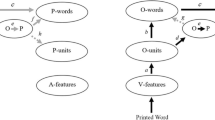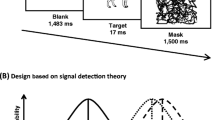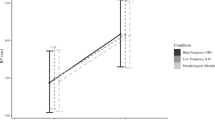Abstract
Three experiments investigated whether production of low-frequency spellings could be influenced by other words containing those spellings. Participants saw visually-presented primes (Experiment 1) or heard primes presented auditorily and produced their spelling (Experiments 2 and 3). Primes either shared both orthography and phonology (e.g., chapl ai n) or only orthography (e.g., ord ai n) with the target word (e.g., porcel ai n). Following the primes, participants attempted to produce the correct spellings of auditorily-presented target words containing low-frequency spellings, such as the ai in porcelain. Participants correctly spelled the targets’ low-frequency spelling more often when preceded by either type of prime, relative to unprimed targets. Furthermore, priming only occurred when the prime’s spelling was produced correctly; primes spelled incorrectly reduced the correct production of target spellings. These results suggest that unlike the priming of nonwords, the basis of lexical priming of real words is orthographic, resulting from the priming of specific graphemes that increases the probability of reactivating the same spelling pattern in the target.


Similar content being viewed by others
Notes
Because of constraints of certain spelling rules, the low- and high-frequency spellings of two targets did not match each other in phonology (siege and weight; exhort and inhabit).
Recent norms for spoken word frequency have been provided by Pastizzo and Carbone (in press), which are very current and have been shown to correlate highly with written frequency counts, such as Kučera and Francis (1967).
Because priming was only found for targets with low-frequency spellings in Experiment 1, Experiment 2 used those targets only, eliminating high-frequency spellings.
References
Barry, C. (1992). Interactions between lexical and assembled spelling (in English, Italian, and Welsh). In C. M. Sterling & C. Robson (Eds.), Psychology, spelling, and education (pp. 71–86). Clevedon, UK: Multilingual Matters.
Barry, C., & de Bastiani, P. (1997). Lexical priming of nonword spelling in the regular orthography of Italian. Reading and Writing: An Interdisciplinary Journal, 9, 499–517.
Barry, C., & Seymour, P. H. K. (1988). Lexical priming and sound-to-spelling contingency effects in nonword spelling. Quarterly Journal of Experimental Psychology, 40A, 5–40.
Bradley, J. M., & King, P. V. (1992). Effects of proofreading on spelling: How reading misspelled and correctly spelled words affects spelling accuracy. Journal of Reading Behavior, 24, 413–432.
Brown, A. S. (1988). Encountering misspellings and spelling performance: Why wrong isn’t right. Journal of Educational Psychology, 80, 488–494.
Burden, V. (1989). A comparison of priming effects on the nonword spelling performance of good and poor spellers. Cognitive Neuropsychology, 6, 43–65.
Burt, J. S., & Tate, H. (2002). Does a reading lexicon provide orthographic representations for spelling? Journal of Memory and Language, 46, 518–543.
Campbell, R. (1985). When children write nonwords to dictation. Journal of Experimental Child Psychology, 40, 133–151.
Deighton, L. C. (1973). Handbook of American English Spelling. New York: Van Nostrand Reinhold Company.
Dixon, M., & Kaminska, Z. (1997). Is it misspelled or is it mispelled? The influence of fresh orthographic information on spelling. Reading and Writing: An Interdisciplinary Journal, 9, 483–498.
Folk, J. R., & Rapp, B. (2004). Interaction of lexical and sublexical information in spelling: Evidence from nonword priming. Applied Psycholinguistics, 25, 565–585.
Hadley, C. B., Abrams, L., & McCord, P. A. (2000, April). Age-linked asymmetries between perception and production in priming misspellings. Poster presented at the 8th biennial Cognitive Aging Conference, Atlanta, GA.
Holmes, V. M., & Ng, E. (1993). Word-specific knowledge, word-recognition strategies, and spelling ability. Journal of Memory and Language, 32, 230–257.
Houghton, G., & Zorzi, M. (2003). Normal and impaired spelling in a connectionist dual-route architecture. Cognitive Neuropsychology, 20, 115–162.
Jacoby, L. L., & Hollingshead, A. (1990). Reading student essays may be hazardous to your spelling: Effects of reading correctly and incorrectly spelled words. Canadian Journal of Psychology, 44, 345–358.
Kessler, B., & Treiman, R. (2001). Relationships between sounds and letters in English monosyllables. Journal of Memory and Language, 44, 592–617.
Kučera, H., & Francis, W. N. (1967). Computational analysis of present-day American English. Providence, RI: Brown University Press.
Norback, P., & Norback, C. (1974). The misspeller’s dictionary. New York: Quadrangle. The New York Times Book Company.
Pastizzo, M. J., & Carbone, R. F. (in press). Spoken word frequency counts based on 1.6 million words in American English. Behavior Research Methods.
Perry, C. (2003). Priming the rules of spelling. The Quarterly Journal of Experimental Psychology, 56A, 515–530.
Proctor, W. (1993). The terrible speller. New York: Quill William Morrow.
Shaw, H. (1993). Spell It Right. New York: HarperPaperbacks.
Snowling, M. J. (1994). Towards a model of spelling acquisition: The development of some component skills. In G. D. A. Brown & N. C. Ellis (Eds.), Handbook of spelling: Theory, process, and intervention (pp. 111–128). Chichester, England: John Wiley.
Treiman, R. (1993). Beginning to spell: A study of first-grade children. New York: Oxford University Press.
Treiman, R. (2003). Phonology and spelling. In P. Bryant & T. Nunes (Eds.), Handbook of children’s literacy (pp. 31–42). Dordrecht, The Netherlands: Kluwer.
Treiman, R., & Barry, C. (2000). Dialect and authography: Some differences between American and British spellers. Journal of Experimental Psychology: Learning, Memory, and Cognition, 26, 1423–1430.
Treiman, R., Berch, D., Tincoff, R., & Weatherston, S. (1993). Phonology and spelling: The case of syllabic consonants. Journal of Experimental Child Psychology, 56, 267–290.
Treiman, R., Mullennix, J., Bijeljac-Babic, R., & Richmond-Welty, E. D. (1995). The special role of rimes in the description, use, and acquisition of English orthography. Journal of Experimental Psychology: General, 124, 107–136.
vos Savant, M. (2000). The art of spelling: The madness and the method. New York: W.W. Norton.
Waters, G., Bruck, M., & Seidenberg, M. (1985). Do children use similar cognitive processes to read and spell words? Journal of Experimental Child Psychology, 39, 511–530.
Acknowledgements
We thank Michael Cortese, Chris Hadley, Lori James, and Tracy Linderholm for their helpful comments on an earlier draft of this article. We also gratefully acknowledge research assistants Stephanie MacLaverty, Melinda Cothern, Shannon Hack, Katie Hoffman, Sean Hoover, Kathryn Lucas, John Parnofiello, Megan Rashid, Andrea Sell, and Kelly Tobaygo, for assistance in data collection and data entry.
Author information
Authors and Affiliations
Corresponding author
Additional information
This research was supported by a University of Florida College of Liberal Arts and Sciences Research Award granted to Lise Abrams and a Sigma Xi Grant-in-Aid of Research awarded to Katherine White. Portions of this research were reported at the 41st annual meeting of the Psychonomic Society in November 2000, the 44th annual meeting of the Psychonomic Society in November 2003, and the 16th annual convention of the American Psychological Society in May 2004.
Correspondence concerning this article should be sent to Lise Abrams, Department of Psychology, University of Florida, PO Box 112250, Gainesville, FL, 32611-2250. E-mail: abrams@ufl.edu. Dunja Trunk is now at Bloomfield College, Department of Psychology, 59 Fremont Street, Bloomfield, NJ, 07003, E-mail: dunja_trunk@bloomfield.edu. Katherine White is now at the College of Charleston, Department of Psychology, 66 George Street, Charleston, SC 29424, E-mail: whitek@cofc.edu.
Appendices
Appendices
Rights and permissions
About this article
Cite this article
Abrams, L., Trunk, D.L. & White, K.K. Visual and auditory priming influences the production of low-frequency spellings. Read Writ 21, 745–762 (2008). https://doi.org/10.1007/s11145-007-9090-x
Received:
Accepted:
Published:
Issue Date:
DOI: https://doi.org/10.1007/s11145-007-9090-x




